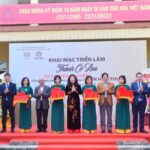On November 23, the exhibition “Ancient Co Loa Citadel – From Legend to Reality” was inaugurated at the Exhibition Hall of the Co Loa Relic Site in Chua Hamlet, Co Loa Commune, Dong Anh District, Hanoi, commemorating Vietnamese Cultural Heritage Day.

The ribbon-cutting ceremony at the exhibition
Organized by the Thang Long-Hanoi Heritage Conservation Center and the Management Board of the Co Loa Relic Site, the exhibition is divided into two themes: The Legend of Co Loa and Co Loa Citadel Today.
The exhibition showcases images, artifacts, and materials curated from scientific projects and research conducted by scholars. It includes materials and images collected by the Ecole Française d’Extrême-Orient (EFEO), special national heritage records from the Thang Long-Hanoi Heritage Conservation Center, photos from the Management Board of the Co Loa Relic Site, as well as private photo collections. Through these exhibits, the cultural values, both tangible and intangible, are conveyed, emphasizing the responsibility of the local community and visitors in conserving and promoting the heritage, contributing to preserving the cultural identity of the nation and supporting local socio-economic development.
The exhibition allows the public to explore the unique features of Vietnam’s oldest ancient citadel, showcasing artifacts such as weapons and tools from the time of King An Duong Vuong.
Co Loa holds significance as one of the capital’s and the country’s historical landmarks. It served as the capital of the state of Au Lac during the reign of King An Duong Vuong (3rd century BC) and later as the capital during the time of King Ngo Quyen (10th century). Particularly noteworthy is the period around the 3rd century BC when the state of Au Lac was established. King An Duong Vuong, with a strategic vision, shifted the national center from Bach Hac (Viet Tri) to the Co Loa region for the construction of the capital. Co Loa Citadel was built on a large scale, bearing testament to the advanced military technology of ancient Vietnamese civilization. Concurrently with the development of wet rice agriculture, especially advanced handicraft industries, the region saw the formation of economically, culturally, and socially developed population centers.
Archaeological excavations have revealed that the structure of Co Loa Citadel consists of three concentric closed circles, extensively excavated during the reign of King An Duong Vuong and subsequently reinforced multiple times. Both within and outside the citadel, numerous traces related to the citadel have been discovered, such as residential sites, traces of casting bronze arrowheads, and locations for burying hidden bronze drums. These findings shed light on legends surrounding the construction of Co Loa, serving as grand evidence of the military genius of King An Duong Vuong, particularly in the crafting and use of bows and arrows.
Throughout its historical ups and downs, Co Loa Citadel has endured the impacts of nature and human activities, undergoing several changes. Nevertheless, it still preserves many testimonies to being the oldest and largest ancient citadel in Vietnam and Southeast Asia during ancient times.
The exhibition is open to visitors starting from November 23.
H.A

